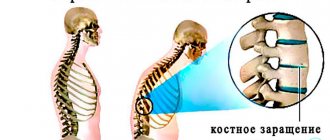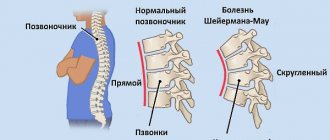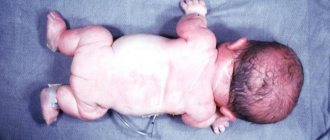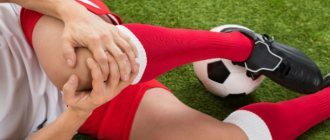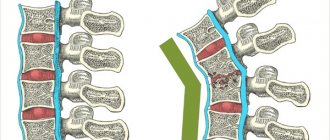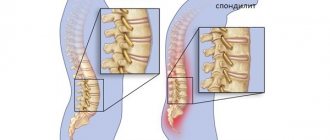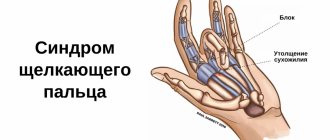All diseases called by proper names have a second name, as a rule, more often used by doctors, but both patients and doctors prefer to call ankylosing spondylitis (BD) the same way. The medical literature uses the term “ankylosing spondylitis/spondyloarthritis.”
Our expert in this field:
Akhov Andemir Olegovich
Traumatologist-orthopedist, oncologist. Member of the Russian Society of Clinical Oncology RUSSCO
Call the doctor Reviews about the doctor
This is a chronic inflammation of the joints, mainly the vertebral and pelvic - sacroiliac, although other joints and even bone at the attachment of muscle tendons and joint capsules can be involved. An important sign of the disease is the formation of adhesions in the joints - ankylosis, which limits movement.
Ankylosing spondylitis is radically different from joint damage in any arthritis, because the bone is not destroyed, but, on the contrary, grows excessively. But a normal structure does not result from this active growth, but more and more bone growths resembling cave stalactites - osteophytes. Ankylosing spondylitis is characterized by involvement in the pathological process of not only the skeleton, but also the choroid of the eye, skin, intestines and heart. But these localizations are not necessary, and what is mandatory for the disease is the gradual and steady progression of inflammation with the involvement of new joints.
Who suffers from ankylosing spondylitis
For quite a long time, BB was mistakenly considered to be characteristic exclusively of men and old people, but it turned out to be completely wrong. Indeed, men get sick three times more often, and a severe course of the disease prevails in them, but women are also affected by this disease, however, it does not at all interfere with procreation. And by and large, the manifestations of the disease do not have gender differences. You can get ankylosing spondylitis at any age; BD has no age preference.
The impression that the process develops only in adults is incorrect. Diagnosis is very difficult, so the child has time to grow up, and only then does it become clear that this is not simple arthritis, but ankylosing spondylitis. In most cases, the diagnosis of the disease is made on average in the eighth year of suffering - there are no specific and characteristic signs only for this disease, and the symptoms can be vague and very varied for a long time. At the initial stage of arthritis, there is a very high sensitivity to conventional non-steroidal anti-inflammatory drugs, which also does not contribute to the continuation of the diagnostic search, because the pain goes away, creating the impression of recovery.
Ankylosing spondylitis affects no more than 1% of the population, and in each age cohort the number of patients is almost the same; it is by no means a disease of aging, like osteoarthritis, which has similar leading symptoms. In the north, people get sick twice as often as in the southern regions, but it is not yet known why. In patients with BD, the HLA-27, ARTS1 and IL23R genes are detected. On the other hand, the presence of these genes does not at all promise an inevitable BD; every 5–7 of those with the “suspicious” HLA-27 gene get sick, and the rest live without problems.
Why exactly this gene is involved in the mechanism of development of BD and what it controls or controls has not yet been determined. A carrier of the HLA-27 gene must have close relatives suffering from spondylitis, and only then the probability of getting sick will be 12%, not very much, but still six times higher than only if you carry HLA-27 without patients in the family.
In explaining the mechanism of development of the disease, they are still leaning towards the typical explanation for all rheumatological processes: some inflammatory agent causes activation of the immune system, but for some reason the immune cells go astray and attack their own tissues. The attack is not a one-time attack, but a long-term chronic one, and what supports this war against oneself is also not clear.
Features of treatment of the disease in women
The main goal of therapy for ankylosing spondylitis is to slow down the ossification of connective tissue and the spine. To achieve noticeable improvement, you need to give preference to complex treatment. Only a doctor can draw up a treatment plan. Self-medication in this case is unacceptable.
A woman with ankylosing spondylitis may be prescribed:
- physical therapy and gymnastics, but in no case during an exacerbation;
- balneology;
- physiotherapy (phonophoresis, ultrasound);
- drug treatment.
Complex treatment of ankylosing spondylitis can be supplemented with physiotherapy. The use of medications plays an important role in the treatment of the disease. Patients are prescribed nonsteroidal drugs, relaxants, selective immunosuppressants, glucocorticosteroid hormones, and corticosteroids.
Local therapy methods are also used, such as:
- cryotherapy with liquid nitrogen;
- hirudotherapy;
- X-ray therapy with anti-inflammatory effect;
- warming up;
- massage sessions.
You can enhance the effect of medications with the help of therapeutic exercises . Exercises for the treatment of ankylosing spondylitis should be vigorous, with amplitude and active movements. They allow you to stop the progression of the disease and the fusion of ligaments.
To get the desired effect, you should exercise regularly (every day) . First, this is done under the supervision of a doctor, then independently. An alternative to exercise therapy can be swimming and swimming.
Lifestyle
Patients with ankylosing spondylitis should reconsider their lifestyle. Following a diet , maintaining an active lifestyle, sleeping on a flat and firm surface, and maintaining posture will help stop the development of the disease
Nutrition plays a critical role in the treatment of ankylosing spondylitis. Protein foods (unfried fish, meat, eggs, dairy products), berries, fruits and vegetables will help speed up the onset of recovery.
As for foods high in starch and baked goods, it is recommended to reduce their consumption. It is better to exclude junk food in the form of processed foods and fast food from the diet altogether.
Why ankylosing spondylitis
People have been suffering from Bekhterev's disease from time immemorial; old hunchbacks were often encountered in painting and literature. But this pathology was described only in the middle of the 16th century. This is the anatomical description that the Italian anatomist made in his anatomical work, who in a not entirely righteous way received two unusual skeletons at his disposal.
And a century and a half later, an Irish doctor found an unusual patient among his patients, whose entire spine and pelvic bones had fused into a monolithic, immovable structure. So, from time to time, someone drew attention to the strange stiff spines of their patients and published cases in the then medical periodicals. And suddenly, at the end of the 19th century, three famous doctors, as in a joke, a Russian, a German and a Frenchman, made a detailed description of chronic damage to the joints of the spine, accompanied by their complete fusion.
Three famous doctors independently observed the patients and published in their national medical journals. The first was the Russian psychoneurologist Vladimir Mikhailovich Bekhterev, his article “Stiffness of the spine with its curvature as a special form of the disease” was published in 1893 in the journal “Vrach”. Four years later, the German Adolf Strumpell described his clinical case, and a year later the Frenchman Pierre Marie. Taking into account the complexity of communications of the century before last, the disease was named in a complex manner Strumpell-Marie-Bekhterev. Our compatriots chose an absolutely fair name for the disease, without thereby detracting from the merits of foreign doctors.
Take care of yourself, book a consultation now
Message sent!
expect a call, we will contact you shortly
Complications from drinking alcohol
If during treatment alcohol is taken occasionally, the condition will not worsen, but constant use is fraught with the following consequences:
- Constant exposure to ethyl alcohol leads to blockage of small vessels, which disrupts the nutrition of cartilage and joints. This negatively affects the condition of the entire musculoskeletal system.
- The leaching of calcium from bones leads to the fact that the spine and joints may not withstand the load and frequent injuries occur.
- Constant consumption of alcoholic beverages leads to drying out of the bone mass, which is fraught with long-term non-healing injuries and fractures, and the appearance of stoop.
- A serious consequence of drinking alcoholic beverages is the inability to form bone tissue in ankylosing spondylitis. This leads to the development of other concomitant pathologies and worsening of the condition.
Constant consumption of alcoholic beverages leads to drying out of bone mass
Clinical manifestations
The disease develops very slowly, gradually involving the entire spine in the pathological process, starting from the bottom and spreading upward. The joints of the vertebrae connecting the sacrum to the pelvic bones are the first to suffer, then the lumbar region is involved, then the thoracic and also from bottom to top, and the joints of the cervical vertebrae are the last to suffer. If the disease spreads haphazardly, “against the grain,” and the joints between the cervical vertebrae are the first to suffer, this is not a good prognostic sign.
In most cases, the process is played out “according to notes”, from the very bottom tier. The sacrum is a monolithic bone consisting of physiologically fused vertebrae, so impaired mobility in the sacroiliac joints goes almost unnoticed. But the lumbar region is made up of five vertebrae, each of which is mobile, and the disorder in the joints responds with the appearance of pain, at first minor and episodic, which goes away after taking regular diclofenac or voltaren.
Pain does not appear during movement, as with radiculitis or arthritis, but at rest, at night, closer to the morning. But a little morning exercise can completely relieve pain. The patient does not immediately notice restrictions in movements, but morning stiffness is felt, does not last long and goes away until the next morning.
Gradually, the pain becomes almost constant, going away only after taking a drug from the group of non-steroidal anti-inflammatory drugs.
The problem with mobility is already felt in the thoracic spine, which affects not only flexibility, but also interferes with deep breathing due to fusions in the spinal-costal joints. Restriction of respiratory movements leads to congestion in the lower parts of the lungs, especially in smokers and heart patients. But in parallel, the hip, shoulder and lower jaw joints may suffer, which is observed in approximately every fourth patient. But the small joints of the hands and feet are almost not involved in the pathological process.
The joints swell and swell; for some the process of inflammation is short, for others it is long. The usual process for all arthritis does not occur inside the joint - there is no destruction of cartilage and bone, but this does not make life much easier for the patient, because the joint is also limited in mobility. The places where the tendons of large muscles attach to the bones may locally hurt, but this is still an uncommon manifestation of BD. Joint stiffness, which is felt as morning stiffness, is included in the diagnostic criteria for joint diseases of a rheumatological nature: rheumatoid arthritis, arthrosis and ankylosing spondylitis.
Recovery prognosis: how long do people live with pathology?
It is impossible to completely cure ankylosing spondylitis, but you can significantly improve the quality of life . The patient's life expectancy is difficult to predict. This depends not only on how quickly treatment is started, but also on the patient’s age, the presence of concomitant diseases, and the stage of development of the pathology.
With proper treatment and diet, a person with ankylosing spondylitis can live about 60-70 years . But in order to achieve this, you will have to change your usual lifestyle, give up bad habits, do special therapeutic exercises, and get rid of excess weight.
It is impossible to completely cure ankylosing spondylitis - it is an irreversible process. Physical activity is contraindicated for such people. Patients with spondyloarthritis die mainly from concomitant pathologies, such as heart attack or stroke, spinal cord damage due to hydraulic fracturing of the spinal column.
Taking a large amount of non-steroidal anti-inflammatory drugs can provoke cancer. The earlier the diagnosis is made, the greater the chance of living to old age. Young people (20-25 years old) diagnosed with ankylosing spondylitis retain motor functions (with minor limitations) throughout their lives.
The main thing is to identify the disease in time and prescribe competent therapy that relieves the inflammatory process in the tissues. In women, the disease is milder, and they are quite capable of even becoming pregnant and giving birth to a child.
In order to maintain joint mobility for a long time, you will have to perform some simple exercises for the back muscles, go swimming, exercise therapy, follow a diet and follow a certain daily routine.
Unusual but typical manifestations
Out of a hundred patients, in only three the disease can begin in a very strange way with damage to the eye, usually its choroid, psoriasis, or inflammation of the intestinal mucosa. These symptoms do not always go hand in hand; more often, with a short interval, the eye sequentially becomes inflamed, turns red, as expected, there is lacrimation and photophobia. An ophthalmologist treats uveitis for a long time and is not entirely successful. The eye disease subsides, then flares up again, tests are taken for various pathogens, however, nothing bad is found.
Afterwards, the patient goes to the dermatologist with some flaky plaques on the skin, and he is diagnosed with psoriasis. But after a couple of weeks, diarrhea with abdominal pain begins, which is dealt with by a gastroenterologist, who, as a rule, connects together everything that has happened in recent months, and refers the patient to a rheumatologist.
A clinical scenario with the development of arrhythmia after damage to the eyes and skin is also possible. During a cardiological examination, inflammation of the inner lining of the aorta is found, which in itself is very rare. The cardiologist connects everything that happened and refers the patient to a rheumatologist colleague.
Or there may be an option with kidney damage, and in any preliminary set of symptoms: skin damage with or without eyes, with or without diarrhea, with or without rhythm disturbance. In general, everything is complicated and unsystematic; if, against the background of such clinical manifestations, there is at least some hint of damage to the joints of the spine, then less time will pass before a correct diagnosis is made.
Conclusion
After studying the information, we can only draw one conclusion: diseases of the joints, spine and alcohol are incompatible.
We should also not forget that any therapy involves taking a large number of medications, and they are not combined with ethyl alcohol. Ethanol will negate all treatment. Medications will either not have the desired effect at all, and, most dangerous of all, they can lead to the development of serious complications.
Our well-being and ability to live an active life depend on the state of the musculoskeletal system. That is why any pathology of the joints and spine should not be ignored. It was not for nothing that in ancient times they said that a person is only as healthy as his spine.
Diagnostics
Of course, early diagnosis is essential for optimal treatment. Only until now, progressive times, a completely specific and characteristic symptom exclusively for ankylosing spondylitis has not been found. There is no laboratory test that would clearly and without doubt make a diagnosis. Special questionnaires help make a diagnosis and determine the severity of the disease.
Clinical criteria have been developed that suggest the presence of ankylosing spondylitis; these are, first of all, inflammatory pain in the spine and limited mobility. But visual diagnostic methods using X-rays do not work at an early stage, and several years may pass before the first radiological manifestations of BD. In the initial stage, diagnosis is based on an analysis of complaints, the history of the appearance of clinical symptoms and objective manifestations of the disease; if it were not for the indices calculated based on the results of a patient interview, one would think that medicine has not come far from the time of Dr. Bekhterev.
X-ray examination of the state of the articulation of the spine with the pelvic bones is the main diagnostic method, and this is where it begins. If sacroiliitis is found - inflammation of the sacroiliac joints, the diagnosis is already in your pocket. If no changes are found, if possible, of course, the patient is referred for an MRI. If the MRI is clear, then they do a CT scan. If nothing but clinical signs support the diagnosis of BD, then x-rays are repeated after a few months.
Recovery prognosis
If ankylosing spondylitis is detected late, the pathology will significantly limit mobility and even threaten disability . At this stage, the patient is offered hip replacement.
But if you do therapeutic exercises every day, get a massage, forget about bad habits and adhere to doctors’ instructions, then you can:
- Stop the pathological process.
- The frequency of exacerbations is significantly reduced.
- Reduce the severity of the disease.
- Maintain a healthy lifestyle.
Men will have to be upset, since ankylosing spondylitis cannot be completely cured, you need to learn to live with it.
Classification of ankylosing spondylitis
There are stages of ankylosing spondylitis and functional classes. Staging involves dividing the disease into early periods and the time of manifestation of pronounced symptoms.
- The first stage is the very initial one, when there are no reliable objective - radiological signs yet, it is called “pre-radiological”, but with MRI they already find absolutely reliable signs of inflammation of the joints between the sacrum and the pelvic bones. Moreover, the inflammation is no longer questionable, but “massive.”
- The second stage corresponds to a full-blown clinical picture, and sacroiliitis is far from being in its infancy, although there are no pathological growths in the joints yet.
- At the third stage, everything that can be in the joints with BD is already present. Years and decades pass from the first to the third stage.
Functional activity classes assess the patient's physical capabilities and answer the question: what can the patient do in everyday life. There are only four classes, starting with the first, when the patient can do everything both at home and at work. With each grade, the ability for non-professional, then professional activities is consistently lost, but self-care remains. The fourth class states restrictions on all types of activities.
We will call you back
Message sent!
expect a call, we will contact you shortly
Medical Scientific and Practical Center for Vertebrology and Neuroorthopedics, Professor M.L. Kurganov
This is a chronic progressive form of arthritis with a predominant localization of the process in the sacroiliac joints, spinal joints and paravertebral soft tissues. First described by V.M. Bekhterev in 1892
Mostly men aged 15-40 years are affected. Women get sick less often. It is believed that the ratio of sick women to men is approximately 1:5-1:9. Although in fact, ankylosing spondylitis does not occur so rarely in women, it just usually occurs much milder than in men, and is therefore more difficult to diagnose. The origin of the disease is associated with hereditary predisposition. Thus, in 90-97% of patients, tissue compatibility antigen type HLA-B27 was detected in the blood. However, why one carrier of the HLA-B27 gene gets sick and another does not has long remained a mystery to many rheumatologists. It was assumed that hidden infections play a role in the development of ankylosing spondylitis, that it is provoked by injuries, hypothermia, colds and viral infections. At the same time, immune disorders characteristic of RA are not detected in ankylosing spondylitis (AS). The trigger is often an infection localized in the genitourinary area, the nature of which cannot always be determined.
On average, approximately 3 people out of every thousand suffer from ankylosing spondylitis.
With this disease, peripheral joints are affected in 50-60% of patients, and in most cases, arthritis precedes damage to the spine. A feature of arthritis in AS is the damage predominantly to the joints of the lower extremities, which in 20-25% of cases occurs as monoarthritis. Joint damage is usually characterized by exudative manifestations and rather late radiological changes (narrowing of the joint space, erosion). Increased inflammatory reactions are not accompanied by pronounced fibrinous changes in the connective tissue and fibrin deposits on the surface of the synovial membrane (V.M. Chepoy et al.).
Development of ankylosing spondylitis
Although the disease is called “ankylosing spondylitis,” ankylosing of the vertebral bodies occurs only in the last phase of its development. In the initial stage, the pathological process is localized in the soft tissues (ligaments) surrounding the spine. The first symptoms are often subtle or appear in the form of “sciatica.” Pain in the lumbar and sacral area increases with coughing, sneezing, sudden movements, especially in the second half of the night. There is weakness, weight loss, increased ESR, often at normal temperature. There is soreness and tension in the back muscles, a decrease in rotational movements in the lumbar spine, and limited flexion and tilt to the side. Stiffness of the spine develops.
In phase 1, the process extends mainly to the lumbar spine and the lumbosacral joint. Then it spreads to the lumbar spine and “creeps” up the entire spine. Recurrent joint effusion may occur.
Phase 2 is characterized by pronounced clinical symptoms. Back pain intensifies, sometimes becomes painful and covers the entire spine with a sharp limitation of all its functions. Damage to the hip joints is associated with limited movement and difficulty gait. An arched curvature of the spine and stooping develop. ESR increases. The first signs of ankylosis appear in the lower vertebrae of the cervical spine. Pain is felt in the back of the head and when opening the mouth, it is difficult to tilt the head and turn the neck around its axis.
The inflammatory process can affect any joints of the body - from the hip to the finger joints. But most often with ankylosing spondylitis, the knee or ankle joints, as well as the tendons of the heel region (“spurs”) or Achilles tendons, become inflamed. In this case, the Achilles tendons can become very swollen, and then they acquire a spindle-shaped shape.
Sometimes damage to the Achilles or heel tendons and pain in the heels in general are the first symptom of ankylosing spondylitis, ahead of inflammation of the spine and joints.
You should be especially wary if pain and inflammation in the heels or Achilles tendons occurs in a young man or woman under the age of 30. If such inflammation is accompanied by severe swelling of the tendon, and if it was not preceded by injury, then in 90% of cases this indicates the inflammatory nature of the disease. And then the patient needs to be checked for ankylosing spondylitis, rheumatoid, reactive or psoriatic arthritis.
Inflammation of tendons and joints in ankylosing spondylitis, fortunately, is rarely as “cruel” as in rheumatoid or psoriatic arthritis. In many cases it can be suppressed quite easily with medication.
In phase 3, the progressive process of ankylosis reaches a high degree . The links of the vertebral bodies of the lumbar and thoracic spine represent a continuous arc. There is a gradual process of “fusion” of the vertebrae with each other, the spine loses its flexibility and mobility. Without proper treatment, complete immobility of the spine can occur over several years, when almost all vertebrae fuse into one rigid bone structure. This condition is called “ankylosis.” The radiograph shows bone ankylosis of the sacroiliac joints, intervertebral and costovertebral joints with the presence of ossification of the ligamentous apparatus.
There are the following forms of ankylosing spondylitis:
1. Central form - damage only to the spine. Occurs in 46% of patients.
2. Rhizomyelic form , in which, in addition to the spine, the shoulder and hip joints are affected. Occurs in 17-18% of patients.
3. Peripheral form , accompanied by damage to the elbow, knee, ankle and other joints. Occurs in 20-75% of patients.
4. Scandinavian form with damage to the joints of the hands.
5. With damage to internal organs : heart (with the formation of heart disease), aorta (aortitis), lungs (fibrosis), kidneys (amyloidosis).
According to the nature of the flow, severe, moderate and mild forms are distinguished. More severe forms occur in young patients. Early diagnosis of the disease is extremely difficult.
In differential diagnosis, it is taken into account that ankylosing spondylitis affects mainly young men; their peripheral joints are more often affected asymmetrically and in the lower extremities. Unlike rheumatoid arthritis, there is no deformation of the small joints of the hand, heel pain, negative reactions to rheumatoid factor, and a favorable response to treatment with indomethacin are characteristic. Ankylosing spondylitis is characterized by eye manifestations in the form of iritis (less often iridocyclitis) with consequences in the form of synechiae. Synechia is a very important symptom in diagnosing the disease. The most informative laboratory test for AC is the detection of the HLA-B27 antigen.
Extra-articular manifestations of AS are no exception. Eye damage (in 10-30% of patients) was discussed above. Involvement of the cardiovascular system in the process (in 20-22% of patients) is diagnosed as aortitis, aortic valve insufficiency, pericarditis and various arrhythmias. Particularly characteristic are disturbances in the conduction system of the heart (blockades). Involvement of the kidneys in the process (31% of patients) is less common than with rheumatoid arthritis. However, renal amyloidosis with the development of chronic renal failure is the most common cause of death in these patients.
Symptoms of ankylosing spondylitis
In approximately 10% of cases, ankylosing spondylitis “starts” from lumbar or cervical radiculitis - that is, the patient feels a sharp “lumbago” either from the lower back in one or both legs, or from the neck to the arm. But much more often, ankylosing spondylitis, as ankylosing spondylitis, as ankylosing spondylitis is also called, begins gradually, gradually. At first, its symptoms may be very similar to those of common osteochondrosis. The patient complains of moderate pain in the lower back, which intensifies after rest and relaxation, as well as with weather fluctuations. But after light exercise and warming up, the discomfort in the back decreases.
At first, back pain is easily eliminated with the help of non-steroidal anti-inflammatory drugs and does not raise doubts among most doctors: “Osteochondrosis in its purest form.” Doubts begin later, when even after several months of therapy for such “osteochondrosis,” the pain not only does not decrease, but even gradually increases. An experienced doctor in such a situation should pay attention to the “inflammatory” nature of back pain: the pain intensifies in the second half of the night, between 3 and 5 o’clock in the morning, and subsides slightly during the day, especially in the afternoon.
In addition to the typical rhythm of pain, a possible diagnosis is indicated by pronounced morning stiffness of the lower back, which also disappears by lunchtime, and the young age of the patient - older people usually suffer from osteochondrosis, and ankylosing spondylitis most often begins at 20-27 years of age.
In addition, in approximately half of patients, already at the very onset of the disease, inflammation of the eyes (redness and a feeling of “sand in the eyes”), increased body temperature and weight loss can be detected.
In 60% of patients with ankylosing spondylitis, inflammation of the spine is combined with damage to the joints. In one form of spondyloarthritis, the knee and ankle joints become primarily inflamed; and with the so-called “rhizomyelic” form of ankylosing spondylitis, the root joints are affected: the shoulder and hip.
There is also a “Scandinavian version” of ankylosing spondylitis, in which the small joints of the hands and feet become inflamed, similar to rheumatoid arthritis. Fortunately, unlike rheumatoid arthritis, joints with ankylosing spondylitis do not undergo “severe” destruction (destruction) and respond quite well to therapy. And in 40% of people with ankylosing spondylitis, joint inflammation does not occur at all (this is the so-called “central” variant of the disease, in which the inflammatory process affects only the spine).
In addition to the above signs of the disease, its most characteristic symptom is increasing stiffness of the spine and limited mobility of the chest during breathing. Restricted chest mobility leads to congestion in the lungs, which negatively affects the patient’s general well-being and provokes various complications - bronchitis, pneumonia, etc. And ossification of the spine leads to the fact that over time the back completely or almost completely loses its flexibility.
The patient moves as if he had a stick inserted instead of a spine - the patient has to bend and turn with his whole body.
The appearance of the patient is characteristic. In the initial stage of the disease, the normal lumbar curve of the spine disappears, and the lower back becomes flat and straight. At a later stage, the thoracic spine “freezes”, strongly hunched over - the so-called “supplicant pose” is formed. The patient's legs always remain slightly bent at the knees when walking.
It is difficult to confuse such a patient in an advanced stage of the disease with a patient with osteochondrosis, especially if damage to the spine is combined with inflammation of the joints; and at this stage most doctors make the diagnosis without difficulty. Unfortunately, it is almost useless to treat such an advanced disease - too many changes occur in the body by this time. Treatment of ankylosing spondylitis should begin much earlier, before “ossification” of the entire spine and inflamed joints has occurred. And for this it is necessary, of course, to make the correct diagnosis as early as possible.
Therefore, I would like to draw attention to two signs by which a patient with ankylosing spondylitis can almost unmistakably be distinguished from one who suffers from osteochondrosis.
The first sign: a patient with osteochondrosis, standing on straight legs and without lifting his feet from the floor, can almost always bend quite low to the side, at least in one direction - to the right or left.
A patient with ankylosing spondylitis will most often not be able to bend far to the side without lifting his feet off the floor: flexion in the lower back with ankylosing spondylitis is impaired in all directions: forward, backward, sideways. In the same way, a person suffering from ankylosing spondylitis can hardly carry out rotational movements along the axis - turning the body to the right or left, without lifting the legs from the floor. With any movements, the spine of a patient with ankylosing spondylitis behaves as a single “ossified” segment, completely devoid of any flexibility.
The second sign: at the initial stage of ankylosing spondylitis, taking non-steroidal anti-inflammatory drugs in an adequate dose almost always immediately gives, albeit temporary, a powerful analgesic effect (in the first hours after taking the drug). Taking non-steroidal anti-inflammatory drugs for osteochondrosis does not always have an effect; and even if pain relief occurs, it is gradual and rarely complete.
Diagnosis of ankylosing spondylitis
If ankylosing spondylitis is suspected, the doctor must urgently refer the patient for an x-ray of the spine and sacrum. For this disease, this diagnostic method is very informative. A competent doctor can easily distinguish on an x-ray both the signs of inflammation of the sacroiliac joints and the emerging “ossification” of the spine.
In addition, it is necessary to conduct a clinical blood test and take blood from a vein to determine inflammatory indicators. An increase in their level (in the presence of other signs of the disease) usually quite reliably confirms the diagnosis of ankylosing spondylitis. In rare cases, when the diagnosis is in doubt, the patient is referred for a specific test to identify the HLA-B27 antigen characteristic of ankylosing spondylitis. Although in some cases the HLA-B27 antigen may not be detected in the blood of patients with ankylosing spondylitis; on the contrary, sometimes it is found in the blood of people who do not have this disease.
Complications caused by ankylosing spondylitis
Ankylosing spondylitis is dangerous not only because over time it immobilizes the entire spine and joints, but also due to its complications. Of these complications, the most dangerous are lesions of the heart and aorta, which occur in 20% of patients and are manifested by shortness of breath, chest pain and interruptions in heart function.
A third of patients develop amyloidosis, a degeneration of the kidneys that leads to renal failure.
Reduced chest mobility contributes to lung diseases and the development of tuberculosis. In order to prevent the occurrence of such complications, it is necessary to identify, diagnose and treat the disease as early as possible.
Treatment of ankylosing spondylitis
The main component of the treatment of ankylosing spondylitis is non-steroidal anti-inflammatory drugs.
Many leading rheumatologists recommend prescribing non-steroidal anti-inflammatory drugs for ankylosing spondylitis in long courses, from 1 to 5 years, continuously.
At times of exacerbation of the disease, the patient is prescribed to take non-steroidal anti-inflammatory drugs in the maximum possible doses, and when the exacerbation subsides, they switch to a maintenance regimen: the patient takes one third or one quarter of the maximum allowable dose of the drug indicated in the annotation for the drug.
It is believed that of all non-steroidal anti-inflammatory drugs, the maximum effect in ankylosing spondylitis is given by diclofenac, indomethacin, butadione, ketoprofen and their derivatives, as well as the selective anti-inflammatory drug movalis. Indomethacin (methindol) 75-100 mg per day and voltaren (ortofen) 100-150 mg per day are effective. Brufen 800-1200 mg per day and reopirin 1 tablet are also used. 3-4 times a day. “Basic” drugs for ankylosing spondylitis are usually ineffective and are rarely prescribed (delagil, plaquenil, gold salts, cuprenil). In patients with severe disease, high fever and visceritis, corticosteroids (prednisolone 15-30 mg per day) and cytostatics (azathioprine, leukeran, etc.) are used. To reduce muscle tone, mydocalm is prescribed 6 tablets per day or 1-2 ml intramuscularly. X-ray therapy is used; it has a direct anti-inflammatory effect on the affected tissue.
To prevent exacerbation, quinoline drugs (delagil, plavknil) are prescribed in a daily dose of 0.25 g for 1.5-2 years. In spring and autumn - indomethacin (metindole) at a dose of 50-75 mg per day for 1.5-2 months.
As a rule, these drugs quickly reduce pain and stiffness in the spine and joints, help improve mobility in them, and also have a positive effect on the patient’s overall well-being.
The effect of these drugs in ankylosing spondylitis is so great that the lack of effect from their use, according to some authors, casts doubt on the correctness of the diagnosis. In the same case, when we are really dealing with ankylosing spondylitis, long-term use of non-steroidal anti-inflammatory drugs can significantly slow down the development of the disease.
As a “basic” therapy for ankylosing spondylitis, the antimicrobial drug sulfasalazine is used, as for rheumatoid arthritis. It helps approximately 60-70% of patients, but the therapeutic effect has to wait quite a long time - about two to three months, or even longer.
The enzyme drug Wobenzym helps many patients. Wobenzym is a combination of highly active enzymes of plant and animal origin. After taking Wobenzym, the enzymes included in the drug are quickly absorbed in the intestines and enter the bloodstream. Then the enzymes, migrating through the blood vessels, enter the site of inflammation and accumulate there.
The enzymes contained in Wobenzyme have a complex effect on the body. They have a mild immunoregulatory, anti-inflammatory and anti-edematous effect, and also slightly improve blood circulation by reducing blood viscosity. In addition, in case of ankylosing spondylitis, Wobenzym helps to increase reduced mobility of the spine.
For local effects directly on inflamed joints, patients are prescribed compresses with dimexide and injections of corticosteroid hormones into the joint cavity.
Cryotherapy of the back with liquid nitrogen has an amazing effect on ankylosing spondylitis. In 90% of cases, cryotherapy with liquid nitrogen brings the patient quick and obvious relief, reduces pain and reduces stiffness of the spine. But home cryotherapy (using improvised means) helps such patients a little.
Back massage is very useful for ankylosing spondylitis. It has a beneficial effect not only on the affected spine, but also on the entire body as a whole. However, massage should only be done during a period of relative well-being, when there are no signs of obvious inflammation and blood tests are normal. During this same period, therapeutic mud was used quite successfully.
Many patients benefit from medicinal leeches. After all, the enzymes contained in the saliva of leeches can have a complex effect on the disease: they “soften” and make the spine more flexible, increase immunity and have an anti-inflammatory effect.
Special protein diets are used relatively successfully for ankylosing spondylitis. Leading rheumatologists recommend that those suffering from ankylosing spondylitis sharply reduce the consumption of baked goods, cookies, pasta, potatoes and other foods containing large amounts of starch. In return, it is proposed to introduce into the patient’s diet a larger than usual amount of meat (preferably boiled), fish, cheeses, cottage cheese, eggs; It is recommended to eat beets, onions, carrots, tomatoes, peppers, garlic, cabbage, cucumbers, herbs, apples, pears and various berries.
Sanatorium-resort treatment is also indicated for people suffering from ankylosing spondylitis. For such patients, the resorts of Pyatigorsk, Evpatoria, Sochi, and Odessa are better suited than others.
But therapeutic exercises occupy a particularly important place in the fight against increasing stiffness and “ossification” of the spine and joints. Gymnastics for ankylosing spondylitis should be carried out as energetically as possible; it is advisable to do all movements very actively, with a wide amplitude.
The bottom line is that such energetic and high-amplitude movements should prevent the fusion of the vertebrae and the “ossification” of the spinal ligaments or joints. Therefore, with ankylosing spondylitis, various bends, turns of the body in all directions, rotation of joints, etc. are fully used.
You need to exercise daily for at least 30-40 minutes. Moreover, it is advisable not to miss a single day! Gymnastics should be done, no matter how bad it is. Every lost day gives the disease an irrevocable piece of a joint or a tiny piece of the spine, which becomes ossified and will never regain mobility!
At the same time, in patients who do not tire of working, fighting the disease, in the vast majority of cases, the progression of ankylosing spondylitis can be stopped. Many patients who have made it a rule to do gymnastics every day without any reservations maintain good mobility of the spine and joints until old age, defeating the disease, and sometimes even ceasing to notice it.
Along with general treatment, UV irradiation, ultrasound, phonophoresis with hydrocortisone, DDT currents, sulfide and radon baths work well. Mud therapy and ozokerite can aggravate the course of the disease. After mud therapy, the disease often progresses, with more and more new joints being involved in the process.
Signs of an unfavorable course
Some symptoms that simply arise or develop during a certain period may indicate a severe course of the disease, the possibility of rapid loss of ability to work, a rapid change in the quality of life, and even a decrease in life expectancy due to the development of adverse complications. These signs are identified in order to change treatment tactics in time by adding other methods or medications to therapy.
The course of the disease is influenced by the development of the disease in childhood and adolescence; in principle, all serious chronic diseases in childhood progress faster and more aggressively, the body grows and everything, including pathological changes, also occurs at an accelerated pace.
Inflammatory changes in the hip joints and neck, as well as episodes of exacerbation of inflammation of the joints of the legs, adversely affect the course of BD; they are evidence of extensive tissue involvement, as well as manifestations of the disease outside the skeleton.
Resistance to non-steroidal anti-inflammatory drugs is also not beneficial for the patient, which may indirectly indicate the production of a large number of inflammatory mediators and the aggressiveness of one’s own immunity against one’s own tissues. On the one hand, X-ray changes help make a diagnosis, but their early appearance indicates an unfavorable rate of progression of the disease.
It is believed that the rapid decline in a person’s physical capabilities is facilitated by the development of BD in the first decade, naturally, against the background of active treatment, and not without it, frequent exacerbations of arthritis of the extremities and damage to the eyes and heart. Severe and persistent pain in the spine with restriction of movements by at least half is unfavorable for the prognosis, which may require a reduction in professional activity. Ankylosing spondylitis, of course, affects the quality of life, but it is a rather long-term disease.
What medications can be prescribed
Depending on the manifestations, the rheumatologist may include the following drugs in the treatment regimen:
- nonsteroidal anti-inflammatory drugs, such as indomethacin and diclofenac, for pain relief;
- hormonal;
- immunosuppressants (if the cause is immune in nature);
- inhibitors of TNF-alpha and B-cell activation;
- chondroprotectors (in the early stages they stop the degradation of joints, accelerate the restoration of cartilage and reduce pain).
As with other joint diseases, ankylosing spondylitis can have different development scenarios. If it is detected too late and left untreated, it can result in disability. In the early stages, a person has every chance to take control of the disease and continue to lead a full life.
